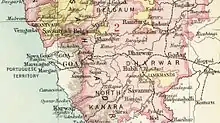Ramdurg State
Ramdurg State was one of the Maratha princely states ruled by the Bhave family during the British Raj. It was administered as part of the Deccan States Agency of the Bombay Presidency, founded in 1799.[1] It was one of the former states of the Southern Maratha Country and its capital was at Ramdurg.
| Ramdurg State | |||||||||
|---|---|---|---|---|---|---|---|---|---|
| Princely State of British India | |||||||||
| 1799–1948 | |||||||||
 Flag | |||||||||
 Ramdurg State in the Imperial Gazetteer of India | |||||||||
| Area | |||||||||
• 1901 | 438 km2 (169 sq mi) | ||||||||
| Population | |||||||||
• 1901 | 37,848 | ||||||||
| History | |||||||||
• Established | 1799 | ||||||||
| 1948 | |||||||||
| |||||||||
Ramdurg State measured 438 square kilometers in area. According to the 1901 census, the population was 37,848.[2]
History
The foundation of the state dates back to 1742 when Ramdurg State was separated from Nargund. During Hyder Ali and Tipu Sultan's time, between 1785 and 1799, Ramdurg was occupied by the Kingdom of Mysore. In 1827 - 1829 Ramdurg State came under the British India administration.
Ramdurg acceded to the Dominion of India on 8 March 1948 and is currently a part of Karnataka state.
Rulers
The rulers of Ramdurg State were Hindu and belonged to the Chitpavan Brahmin caste with the surname Bhave. The Diwan or Regent of the state belonged to another Chitpavan Brahmin family with surname Ranade. The rulers from Bhave family used the title of Raja.[3]
Rajas
- 1742 - 1777 Yogirao I Bhave
- 1777 - 1785 Ramrao I Bhave (d. 1800)
- 1785 - 1799 occupied by Mahisur (Mysore)
- 1800 - 1810 Bapurao Ranade -Regent
- 1810 - 1827 Narayanrao I Ramrao "Appa Saheb Bhave" (d. 1827)
- 1827 - 1829 British administration
- 1829 - 1857 Rani Radhabai (f) (d. 1857)
- 1857 - 1872 Ramrao II Narayanrao Bhave
- 1872 - 1878 Yogirao II "Bapu Saheb" Bhave (b. 1852 - d. 1878)
- 11 Feb 1878 - 1907 Vyankatrao Yogirao Bhave (b. 1877 - d. 1907)
- 30 Apr 1907 - 1947 Ramrao III Vyankatrao Rao Saheb Bhave (b. 1896 - d. 19..)
References
- Imperial Gazetteer of India, Oxford: Clarendon Press, 1908
- "Imperial Gazetteer of India, v. 21, p. 172. "Rāmdurg State"".
- List of rulers of Ramdurg